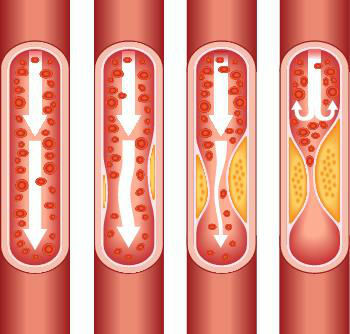O cholesterol it is a fatty monounsaturated alcohol that is found naturally in our bodies. It is part of the group of natural steroids, which are lipids (fats) that have in their structure four cycles formed by 17 carbon atoms.

Cholesterol structure and part that is common to all steroids
All of our cells can synthesize cholesterol, but it is mainly produced in the liver and intestine. This lipid is important for the proper functioning of the human body, as our tissues use it for vital functions, such as producing male and female sex hormones, for cell membrane synthesis and for vitamin production. D.
Cholesterol can also be absorbed by the body through food. The main sources of cholesterol in the diet are eggs, red meat, cream and butter.The more cholesterol consumed, the less it will be produced in the body.
Since it is fatty, it cannot dissolve in water and therefore is not carried by blood plasma alone. For this transport to occur, plasma lipoproteins are formed, which, being proteins, have a part that interacts with fats (non-polar part) and a part of the polar structure that interacts with media aqueous. Thus, the proteins originate spherical micelles that contain cholesterol and lipids inside, and the outside interacts with the aqueous medium, transporting them through the blood.
Do not stop now... There's more after the advertising ;)
Depending on the combinations between cholesterol, lipids and proteins, two types of lipoproteins with different densities, which are commonly known as "good cholesterol" and “bad cholesterol”. Note that there is actually only one type of cholesterol, but two types of lipoproteins.
The call "good cholesterol" it's the HDL or high density lipoprotein, as its density is between 1.063 and 1.210 g/mL. It is considered good because it carries cholesterol from body tissues back to the liver for the metabolism or excretion of bile, cleans the arteries and decreases the risk of disease cardiovascular diseases.
already the "bad cholesterol" it's the LDLor low density lipoprotein(between 1.006 and 1.063 g/ml). High levels of LDL in the body are harmful because it plays the opposite role of HDL, that is, it transports the cholesterol produced in the liver to the tissues of the body, which causes their accumulation in the walls of the arteries, which can lead to their clogging (arteriosclerosis).

In arteriosclerosis, the blood flow through the artery is obstructed.
Changes in diet, such as a balanced diet and reduced intake of foods rich in saturated fat, accompanied by exercise, can lower cholesterol levels in the body.
By Jennifer Fogaça
Graduated in Chemistry
Would you like to reference this text in a school or academic work? Look:
FOGAÇA, Jennifer Rocha Vargas. "What is cholesterol?"; Brazil School. Available in: https://brasilescola.uol.com.br/o-que-e/quimica/o-que-e-colesterol.htm. Accessed on June 28, 2021.
Chemistry

Density, heart disease, low density lipoproteins, bad cholesterol, walls of arteries, good cholesterol, high-density lipoproteins, LDL, HDL, myocardial infarction, attack cardiac.


